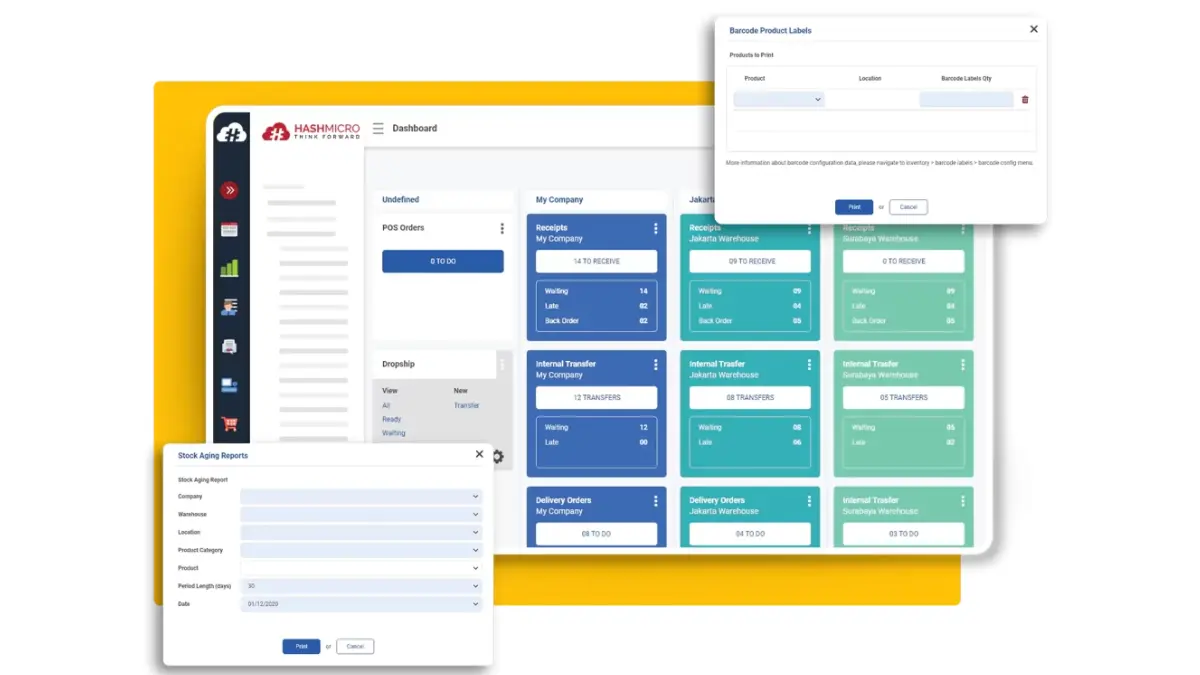Hate wasting time on repetitive tasks? So do we. Manual stock replenishment can feel like a never-ending cycle—counting, tracking, and reordering inventory over and over again. It’s frustrating, time-consuming, and prone to human error. What if you could break free from this tedious process?
By automating your inventory replenishment, you can eliminate the monotony, reduce mistakes, and ensure your inventory is always optimal. Want to stop wasting time and start focusing on what really matters for your business? Let us show you how to revolutionize your stock management in 2025.
Key Takeaways
|
Table of Contents
What is Stock Replenishment?

Stock replenishment refers to restocking inventory to maintain optimal levels and avoid shortages. This practice is vital for ensuring that businesses have the right amount of stock to meet customer demand while avoiding overstocking, which can lead to unnecessary costs.
It’s important because stock replenishment’s ability to balance supply and demand can minimize the risk of stockouts or excess inventory. As a business owner, you can reduce costs by automating their replenishment processes while ensuring they never run out of best-selling items.
Stock Replenishment vs Inventory Control
Stock replenishment and inventory control are related but serve different roles in a business’s supply chain. Inventory control manages and tracks overall stock levels for accuracy, while stock replenishment ensures timely ordering when inventory runs low.
Understanding this distinction will help businesses to create a well-rounded inventory management strategy. When both practices are combined, businesses can achieve smoother operations and higher profitability.
Why is Stock Replenishment Important?
Stock replenishment is crucial for maintaining a steady flow of products, ensuring that businesses can meet customer demand without interruptions. It helps prevent stockouts, which can lead to lost sales, and overstocking, which ties up capital unnecessarily.
By optimizing inventory replenishment, businesses can reduce operational costs, improve customer satisfaction, and stay competitive in an evolving market. Effective replenishment also enhances inventory management, enabling businesses to respond quickly to changes in demand and avoid supply chain disruptions.
How Does Stock Replenishment Work?
Stock replenishment is vital to ensure businesses always have the right amount of inventory to meet demand. It works by following steps that monitor stock levels, and trigger reorders when necessary. Businesses use this process to maintain balance, avoid overstocking, and prevent stockouts that could lead to lost sales.
Here’s a step-by-step guide on how stock replenishment works:
- Monitor Stock Levels: Regularly track inventory to ensure it doesn’t fall below a certain threshold.
- Set Reorder Points: Establish predefined reorder points based on product demand and lead time.
- Trigger Reorder: Once the stock reaches the reorder point, an order for new inventory is initiated.
- Order Placement: Send the reorder to suppliers, either manually or through automated inventory systems.
- Receive Stock: When new stock arrives, update inventory levels and store items in the appropriate location.
- Adjust Inventory Levels: After receiving the stock, adjust and verify inventory records to ensure accuracy.
By following these steps, your business can automate and streamline its replenishment process, reducing manual effort and improving efficiency. By using an optimized stock replenishment system, you can ensure products are always available, improving customer satisfaction and operational effectiveness.

Best Practice to Replenish Stock
Replenishing stock effectively is crucial for maintaining a smooth supply chain and meeting customer demand. By following best practices, businesses can ensure they have the right products on hand without overstocking or encountering shortages. Implementing these strategies can help improve efficiency and minimize the risks of stockouts.
Here are four best practices for replenishing stock:
- Set Accurate Reorder Points: Determine optimal reorder points for each product based on demand patterns and lead times.
- Use Demand Forecasting: Leverage historical data and market trends to predict future stock needs and adjust accordingly.
- Automate Replenishment Processes: Implement inventory management software to automatically track stock levels and trigger reorders when needed.
- Maintain Safety Stock Levels: Keep a buffer of extra inventory to prevent stockouts during unexpected demand spikes or supplier delays.
By adopting these best practices, businesses can streamline their stock replenishment process, reduce manual efforts, and ensure they always have the right products available. This leads to improved efficiency, reduced costs, and enhanced customer satisfaction.
Demand Forecasting Techniques
Demand forecasting is one of the most critical aspects of stock replenishment, which involves predicting future sales to ensure adequate stock levels. Techniques such as historical data analysis, market trend evaluation, and customer behaviour patterns help businesses accurately forecast demand.
Additionally, demand forecasting is enhanced through advanced analytics tools that allow for real-time data tracking. Businesses can leverage these tools to respond quickly to market changes, ensuring their replenishment strategies remain effective throughout the year.
Periodic vs. Demand-based Replenishment
Periodic replenishment involves restocking inventory at set intervals, such as weekly or monthly, regardless of actual demand. This method works well for stable markets with predictable sales patterns.
In contrast, demand-based replenishment adjusts to real-time changes in customer demand, making it more suitable for dynamic markets like those in the Philippines.
Both methods have their strengths, and businesses may use a hybrid approach depending on their industry and market conditions.
Optimizing Warehouse Space and Layout
An effective stock replenishment strategy isn’t just about ordering new stock but also how that stock is stored. Optimizing warehouse space and layout directly impacts replenishment efficiency. For Filipino businesses, where warehouse space can be limited, using it wisely is essential for streamlining operations and cutting overhead costs.
Technologies like 3D warehouse systems help create efficient layouts and optimize shelving arrangements. These tools allow businesses to visualize storage setups and make improvements easily.
Well-organized warehouses ensure faster stock retrieval, accurate inventory counts, and smoother replenishment cycles. Businesses strategically positioning high-demand products reduces order fulfilment time and enhances overall efficiency.
Future Trends and Innovations in Stock Replenishment
As technology advances, businesses are finding new ways to streamline stock replenishment through automation, data analytics, and artificial intelligence. Staying updated on these trends can give businesses a competitive edge.
Some things businesses, especially in the Philippines, need to be aware of are:
Adapting to changing market demands
As we look toward the future, businesses must be prepared to adapt to changing market demands. Consumer preferences and economic conditions are rapidly evolving in the Philippines, so inventory replenishment strategies must be flexible.
By staying updated on market trends, businesses can anticipate changes in demand and adjust their stock levels accordingly. Technology will continue to play a significant role in this adaptation. Businesses that embrace digital solutions and data analytics will be better equipped to improve their response to market shifts.
The use of Inventory Management Software
Using inventory management software can revolutionize how businesses handle stock replenishment. These tools provide real-time visibility into stock levels, automate replenishment processes, and improve accuracy in demand forecasting.
The benefits of using this software go beyond just tracking stock. It can help businesses automate reordering, track supplier performance, and generate reports that provide insights into stock turnover rates. This allows business owners to make informed decisions that improve profitability and reduce waste.
Automate Stock Replenishment Using HashMicro’s Inventory Management Software

Automating stock replenishment with HashMicro’s Inventory Management Software helps businesses streamline processes and enhance efficiency. By leveraging advanced features, businesses can reduce manual tasks and optimize their inventory management system.
Here are six features of HashMicro’s software that can revolutionize your stock replenishment process:
- RFID Warehouse Rack Stock In/Out Automation: Automate stock movements using RFID technology, ensuring accurate tracking and faster stock updates.
- Stock Forecasting: Predict future stock needs based on historical data to prevent overstocking or stockouts.
- FEFO (First Expiry First Out): Prioritize the usage of products with the closest expiration dates, ensuring reduced waste and optimized stock rotation.
- Stock Optimizer per Warehouse: Allocate inventory efficiently across multiple warehouses based on demand and storage capacity.
- 3D Warehouse: Visualize and optimize warehouse layouts, improving space utilization and streamlining stock storage.
- Lot & Serial Number Management: Track products by lot or serial numbers for better traceability and streamlined stock management.
With these features, HashMicro’s Inventory Management Software helps businesses automate stock replenishment and ensure optimal stock levels across all warehouses. By utilizing an advanced inventory software like this, you can focus on growth and customer satisfaction without worrying about manual stock management.
Conclusion
Manual stock replenishment can be time-consuming, repetitive, and prone to errors. Automating this process saves time and ensures that inventory levels are maintained efficiently. By implementing advanced inventory replenishment strategies, businesses can reduce mistakes and focus on more critical aspects of their operations.
With HashMicro’s Inventory Management Software, businesses can take their stock replenishment to the next level. Automate processes and optimize your operations for 2025 and beyond. Ready to experience these benefits firsthand? Schedule a free demo today and see how HashMicro can revolutionize your stock management.

Frequently Asked Questions
-
What is the method of stock replenishment?
Stock replenishment methods include periodic and demand-based strategies to maintain optimal inventory levels. These methods help businesses restock products efficiently, preventing stockouts and overstocking.
-
What is a replenishment process?
The replenishment process involves monitoring stock levels and reordering inventory when it reaches a set point. It ensures businesses maintain adequate stock to meet customer demand while avoiding shortages.
-
What does stock replenishment do?
Stock replenishment helps businesses keep inventory at ideal levels by restocking when necessary. This process prevents product shortages and excess stock, improving overall operational efficiency.




































